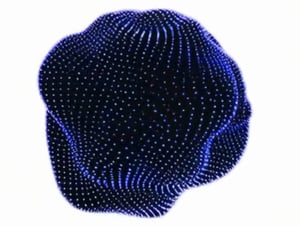See your best design before you build it
Allsolve creates the data; MultiphysicsAI delivers the insights.

See your best design before you build it
Allsolve creates the data; MultiphysicsAI delivers the insights.
The key advantages
Explore thousands of viable design options in seconds.
See the full design space before you choose.
Create your own training data with Allsolve in hours.
Why MultiphysicsAI?
Traditional tools tell you what one design does. Engineers need to know which design to build under competing objectives, manufacturing limits, and deadlines.
MultiphysicsAI reveals the full design space so you can see all best trade-offs, move from specs to viable candidates, and verify you didn’t miss a better option.

How MultiphysicsAI works
1. Create proprietary training data
Run up to millions of natively coupled simulations in parallel with Quanscient Allsolve to produce unique multiphysics datasets owned by you.

2. Train physics-aware neural networks
Use that data to train a surrogate that can make hundreds of thousands performance predictions in milliseconds.
.png?width=300&name=physics-aware-neural-network-training%20(1).png)
3. Decide with full design-space visibility
The fast model reveals the design landscape, surfaces the few best trade-offs, and shows which options meet your goals—instantly.

4. Verify before you choose
Validate the top options with Allsolve so every decision is grounded in physics.

Real-world examples
Ultrasound transducer
A dataset was generated, a fast model revealed the best trade-offs, and Allsolve verified designs with higher bandwidth and sensitivity. Open the white paper -->
.png?width=300&name=pmut%20stage%201%20(1).png)
1. Dataset in minutes
10 000 Allsolve runs across geometry variants and four KPIs.
View full-size.png?width=300&name=pmut%20stage%202%20(1).png)
2. Millisecond screening
A surrogate model estimates performance in milliseconds.
View full-size.png?width=300&name=pmut%20stage%203%20(1).png)
3. Best trade-offs, visible
See the designs that best balance bandwidth and sensitivity.
View full-size.png?width=300&name=pmut%20stage%204%20(1).png)
4. Quantifiable improvements
Final simulation with Allsolve confirms it: bandwidth improved 65% → 100% with +6.5% sensitivity.
MEMS microspeaker
The design space was mapped in minutes, top options were surfaced, and Allsolve confirmed about 30% more loudness with distortion kept low. Open the white paper -->
.png?width=300&name=microspeaker%201%20(1).png)
1. Dataset in minutes
Allsolve generated a dataset of 12 500 nonlinear simulations in less than 20 minutes.
.png?width=300&name=microspeaker%202.1%20(1).png)
2. Train a fast AI model
That dataset was turned into an instant “what-if” engine for new design ideas.
.png?width=300&name=microspeaker%203%20(1).png)
3. See the best options and trade-offs
The strongest trade-off (louder sound with lower distortion) were surfaced, making shortlisting easy.
View full-size.png?width=300&name=microspeaker%204%20(1).png)
4. Verify the winners
Top picks were re-simulated in Allsolve: ~30% more loudness with the distortion kept the same.
View full-sizePiezocomposite
After the dataset was generated in under 10 minutes, the best bandwidth–sensitivity trade-offs were revealed in seconds, and top candidates were quickly validated in Allsolve.

1. Fast training data generation
A dataset of 10 000 simulations with randomised geometry in less than 10 minutes.

2. Instant design space visibility
See the set of best designs in seconds balancing bandwidth and sensitivity at the wanted frequency.

3. Validation grounded in physics
Validation of the best candidates with Quanscient Allsolve.
Piezoelectric material characterization
A "reverse engineering" workflow where the AI is trained to instantly identify complex, unknown material properties from experimental data, solving a notoriously difficult industry inverse problem.

1. Dataset generation
Ran 10,000 simulations of a bulk PZT disc, randomizing both the material properties (stiffness, coupling, permittivity) and geometry for each run.
View full-size
2. Inverse AI training
Trained an AI model to "work backwards" taking the simulation outputs (impedance magnitude and phase) and predicting the material property inputs.

3. Instant characterization
The model can now input a complex impedance spectrum and output the correct material properties in milliseconds.
View full-size
4. Quantifiable accuracy
In validation tests, the AI predicted the difficult-to-determine material matrices with error rates significantly less than 5%.
View full-sizeReal-world examples
Ultrasonic transducer
A dataset was generated, a fast model revealed the best trade-offs, and Allsolve verified designs with higher bandwidth and sensitivity.
.png?width=300&name=pmut%20stage%201%20(1).png)
1. Dataset in hours
~10,000 Allsolve runs across geometry variants and four KPIs.
Ultrasonic transducer
A dataset was generated, a fast model revealed the best trade-offs, and Allsolve verified designs with higher bandwidth and sensitivity.
.png?width=300&name=pmut%20stage%201%20(1).png)
1. Dataset in hours
~10,000 Allsolve runs across geometry variants and four KPIs.
Ultrasonic transducer
A dataset was generated, a fast model revealed the best trade-offs, and Allsolve verified designs with higher bandwidth and sensitivity.
.png?width=300&name=pmut%20stage%201%20(1).png)
1. Dataset in hours
~10,000 Allsolve runs across geometry variants and four KPIs.
MultiphysicsAI roadmap 2026
Scriptable workflows
- Forward and inverse studies programmatically
- Map parameters to KPI surrogates for rapid what‑ifs and target‑seeking
No-code training & inference
- GUI to train and apply surrogates for small–mid complexity meshes
Larger models & built-in optimization
- Mid–large meshes; full-field predictions
- Built-in optimization (geometry, materials, operating points)
Domain-specific foundation models
- Narrow-domain pre-trained foundational models (huge meshes)
- Fine-tune to your model with less data
What MultiphysicsAI enables
Screen thousands of candidates in seconds.
Clear charts of the best trade-offs make multi-objective decisions tangible and defensible.
Start from targets and constraints; surface candidates that you can build.
Stress-test to tolerances; verify margins before prototyping.
Reserve high-fidelity solves for finalists only.
FAQ
Multi-objective design and optimization where each simulation is expensive and trade-offs matter: e.g., electromagnetics, acoustics, thermal-structural coupling, power electronics, batteries, RF, and MEMS.
As of now, MultiphysicsAI is delivered as a scoped project that we run end to end: you get validated design candidates, clear trade-offs, and a decision-ready report.
In 2026, it will be available inside Allsolve (first scriptable, then no-code).
If you’re interested, get in touch now to secure a project slot and be first in line for early product access.
.jpg?width=300&name=startup%20program%20background%20(1).jpg)
How could physics-aware AI benefit you?
Get in touch now to discover the opportunities MultiphysicsAI could open for your work.
Case examples and other resources
%20(2).jpg?width=300&name=event-listing-1%20(2)%20(2).jpg)
White paper
Quanscient MultiphysicsAI for PMUT design
See the full step-by-step example of improving ultrasound transducer design with Quanscient MultiphysicsAI.
Open white paper →
%20(1).jpg?width=300&name=event-listing-1%20(4)%20(1).jpg)
White paper
Quanscient MultiphysicsAI for MEMS microspeaker design and optimization
A full breakdown of a MEMS microspeaker case with AI-driven design exploration.
Open white paper→
.jpg?width=300&name=event-listing-1%20(3).jpg)
White paper
Accelerating engineering design with neural surrogates
Learn the 5 key stages for accelerating engineering work with neural surrogates.
Open the white paper→

Find out how physics-aware AI could benefit you
Curious what this could enable for you?
Fill in the form and let's talk about how this could give you an advantage — whether you're an Allsolve user or not.
- How MultiphysicsAI could help with your product development processes
- The practical results you could realistically expect with physics-aware AI
- Simple next steps and recommendations
Get in touch now – see how physics-aware AI could help you today!